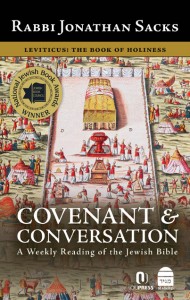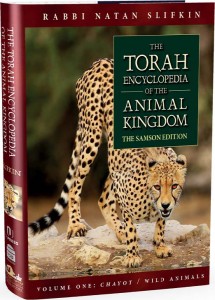Covenant & Conversation: A Weekly Reading of the Jewish Bible— Leviticus: The Book of Holiness/The Torah Encyclopedia of the Animal Kingdom—Volume 1: Chayot/Wild Animals
 Covenant & Conversation: A Weekly Reading of the Jewish Bible— Leviticus: The Book of Holiness
Covenant & Conversation: A Weekly Reading of the Jewish Bible— Leviticus: The Book of Holiness
By Rabbi Jonathan Sacks
OU Press and Maggid Books
Rabbi Jonathan Sacks has become renowned as one of the foremost expositors of Judaism, and of religion as a whole, in society today. Covenant & Conversation: Leviticus reminds us why this is the case. This brief review will focus on Rabbi Sacks’ introductory essay, which explains the relevance of Vayikra to modern man and stands as a masterpiece on its own.
Rabbi Sacks opens by noting that Vayikra is, “of all the Mosaic books, the one most out of step with contemporary culture. Many find it difficult to relate to its concerns. It opens with an account of sacrifices, something we have not experienced for close to two millennia. Its preoccupation with ritual purity and defilement seems to come from another age.” But the key to understanding Vayikra, Rabbi Sacks argues, is to understand holiness.
What is holiness? “Holiness is a break in the self-sufficiency of the material world, where infinity enters space and eternity enters time.” If the existence of the universe is only possible through an act of Divine withdrawal, tzimtzum, holiness is only possible through human withdrawal, allowing the infinite God into our finite world. “The holy, in short, is where human beings renounce their independence and self-sufficiency, the very things that are the mark of their humanity, and for a moment acknowledge their utter dependence on He who spoke and brought the universe into being.” In other words, holiness means sacrificing ourselves—and this in turn is “the truth at the heart of Leviticus,” the common denominator between the Temple rituals and the command to love your neighbor. Vayikra teaches that “there is no love without the willingness to sacrifice.”
Modern readers find Vayikra’s focus on the rituals of sacrifice alien, but what they forget is that “the priestly ritual is the choreography of love.” The ritual aspects of Judaism, Rabbi Sacks explains, represent Judaism which “is not just poetry, but also prose, not just the fire of romantic love but the daily kindnesses of a successful marriage, not just an exalted faith in the transcendent God but the way it takes faith and translates it into everyday life.” This insight into the nature of Judaism remains true in a world without the Temple and its sacrifices. “Judaism continues to be a religion of rituals,” Rabbi Sacks notes, “and it is this that sustains its continuity through time, etching its days with the charisma of grace, more like a marriage than a romance but no less moving for the quietness of its beauty.” This is the standing-on-one-foot version of Rabbi Sacks’ message. For the full version, which encompasses much more than could be included here, we must paraphrase Hillel’s words to the convert: “Go get a copy of Covenant & Conversation: Leviticus, and study!”
 The Torah Encyclopedia of the Animal Kingdom—Volume 1: Chayot/Wild Animals
The Torah Encyclopedia of the Animal Kingdom—Volume 1: Chayot/Wild Animals
By Rabbi Natan Slifkin
OU Press, The Biblical Museum of Natural History and Maggid Books
Rabbi Natan Slifkin demonstrates why he has become acclaimed as the “Zoo Rabbi” with his newest book, The Torah Encyclopedia of the Animal Kingdom—Volume 1: Chayot/Wild Animals. This book contains an encyclopedic array of information relating to everything from the fearsome to the fluffy: lions and leopards and bears, but also hyraxes and hares.
Rabbi Slifkin gathers together all scriptural references to the animals he discusses, as well as sources from the Talmud, Midrash and later rabbinic literature about the identity, laws, symbolism and significance of the animals in the Torah. In addition, Rabbi Slifkin combines his Torah erudition with wide-ranging knowledge of zoology and natural history, drawing on the latest academic findings to understand Torah sources. Despite his painstaking research, this work is written in an accessible style aimed at all Jewish animal lovers. The beautiful color photographs that accompany the text evoke the words of King David: “You make darkness, and it is night; wherein all the beasts of the forest do creep forth. The young lions roar after their prey, and seek their meat from God. The sun arises, they gather themselves together, and lay them down in their dens . . . O Lord, how manifold are Your works! In wisdom You have made them all; the earth is full of Your riches.” For anyone seeking to explore those riches from within the Jewish tradition, The Torah Encyclopedia of the Animal Kingdom is the definitive resource.
